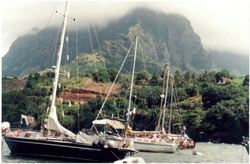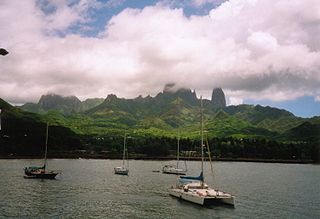20 Years Ago Today -- May 6, 1996 -- Day 28
 Thursday, May 5, 2016 at 12:15AM
Thursday, May 5, 2016 at 12:15AM Sun. 96-05-05 - Day 28 - Hiva Oa, Marquesas, French Polynesia 9° 50' S 139° 02' W Log: 2,688nm
I got up at ~1900Z, with Hiva Oa about 10 miles off. Mostly sunny tradewind weather, blowing 15 - 18 from ESE. Very cloudy over Hiva Oa, so not worth a landfall photo.
We had hooked another 30" wahoo in the night and dragged it for a long time on John's watch, so when I had landed it, the eyes were gone. I cleaned it after breakfast as we sailed up to Hiva Oa and we put the skinny little fillets in the fridge. We talked to Upshot (British) and Cat's Paw IV (Bluewater Cruising Association) on the way in, as both were ahead of us. It took a long time for us to sail along the south coast of the island, as it is high and steep-shored. The very west end was pretty dry, and had little vegetation on it, and reminded me of California's Channel Islands. We were still sailing with reefed main and staysail, which was perhaps a bit undercanvassed.
Isle Motane was clearly visible to our south, and Tahu Ata ahead, until we turned north into Baie Taaoa, and finally NE into Baie Taahuku, a mile or so east of the town of Atuona. The village appears to be quite high up, as there is little shore-level land. There did appear to be about a 3-story building on the beach below the town, though -- I didn't expect any multi-story structures.
 The anchorage at Baie Taahuku is protected by a breakwater, but pretty rolly, and surgy from reflected and refracted waves from around the point. There were about 15 boats in harbour when we arrived, anchored bow and stern [pictured at left]. As room must be left for large vessels to dock at the "wharf", all anchoring must be behind a line marked with a transit on the south shore of the bay.
The anchorage at Baie Taahuku is protected by a breakwater, but pretty rolly, and surgy from reflected and refracted waves from around the point. There were about 15 boats in harbour when we arrived, anchored bow and stern [pictured at left]. As room must be left for large vessels to dock at the "wharf", all anchoring must be behind a line marked with a transit on the south shore of the bay.
We arrived in the anchorage ~0100Z, anchoring near Celebration, with Marc Edge taking our stern hook in his dinghy. Both Marc from Markenurh and Ken from Celebration had come out in their dinghies despite a rain squall at the time. It seemed to rain about once every 15 minutes all afternoon. We were anchored at 15:20 local time (Z - 9.5h). Marc invited us for supper for ~17:30 and congratulated us on our passage. Ooh, baby, we made it!
We got settled and took the dinghy ashore. The bay has fresh water (galore), including a shower stall available free and a big place to wash clothes near the dingy landing. There's a concrete landing which is quite surgy and a stern anchor is required to keep the dingy from getting under the wharf. Another choice (which we used the first time) is a gravel launch ramp around the corner, with less surge, but you have to carry the dinghy out of the way.
We filled the water tanks and had showers (very welcome!) and chatted with a few cruisers. A bit wobbly walking, but not bad.
After a beer and fresh clothes aboard Vahevala, we headed over to Markenurh, bringing one of John's trusty bottles of Padre Kino red wine (Mexican). Besides Marc and Adrien and Sylvia, Ken and Hillary from Celebration, and Jim and Penny from Cat's Paw IV were there. [I had previously sailed for a few weeks between Puerto Vallarta and Manzanillo aboard Vancouver-based Markenurh with Marc, Adrien and Sylvia.]
We had a really nice time, with Marc serving his famous pizzas, salad and good company. Our 27-day [sic] passage compared well with most of the others, although Celebration did it in 17 days [Celebration is a Carpenter 37 from Aukland, NZ that did the Melbourne to Osaka race last year, and then crossed to Canada. I saw their boat in Victoria in July and in Nanaimo in August, then in San Diego in November, La Paz in Jan/Feb, and Puerto Vallarta in March, where I had finally spoken with them. Nice folks.] Cat's Paw IV is a Fast Passage 37.
It turns out that there were various rumours about Vahevala on the HAM/SSB nets, including that we were overdue and that we were headed for the Cook Islands (!?). Ah, rumours.
We turned in about 21:30 for the first full night's sleep in nearly a month. No CDs.
 [Ed.: Well, that's the end of the big offshore passage. There were lots of great and memorable experiences (including this one, mentioned previously) in the Marquesas and further West, but I'll stop here with the log. This passage inspired me to write a song a couple of years ago, which I'll post here in the near future.
[Ed.: Well, that's the end of the big offshore passage. There were lots of great and memorable experiences (including this one, mentioned previously) in the Marquesas and further West, but I'll stop here with the log. This passage inspired me to write a song a couple of years ago, which I'll post here in the near future.
I would like to express thanks to my brother John and his wife Laura, who gave me this lovely leather-bound log book for recording my trip, and which is still in excellent shape 20 years later.
And of course finally a great thank-you to my skipper, John, who welcomed me aboard Vahevala and gave me this great opportunity.]
 Dave | Comments Off |
Dave | Comments Off | 